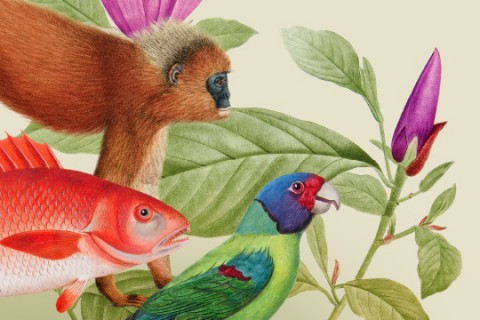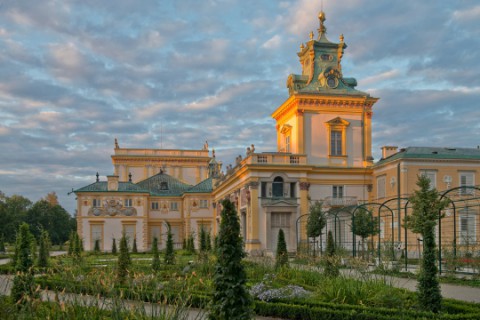In the museum of culture and nature

The subordination of the natural world to human needs was for centuries accepted as an axiom requiring no justification. Both the intensity and the extent of the contemporary discourse on the likely consequences of this anthropocentric intrusion are long overdue. We are thus increasingly often faced with a crucial question: is the strained relationship between humans and the world doomed to a tragic finale?
Harmonious use of natural resources is history. We are currently living in an age that many eminent scholars believe could be humanity’s last. Where we were once cradled by our surrounding landscape, today it is we who are transforming it, offensively and incommensurably.
***
Royal Wilanów has the potential to serve as a microcosmic exemplification of the challenges posed by our contemporary life.
The venue for the second showing of the exhibition ‘Plants and animals. Atlases of natural history in the age of Linnaeus’ was not chosen at random. In the days of King Jan III himself, this was a noble periphery nestled in unspoilt natural surroundings, a glorious, relaxing retreat. Today, however, it is part of a large metropolis, an expanding city, whose rapid spread is destabilizing the natural rhythms of the local ecosystem.
Placing this extraordinary visual story in the spatial context of this historic Polish landed estate reminds us that communing with nature has always been an aesthetically exquisite and spiritually enriching experience for humankind. Contact with nature has provided the best conditions for contemplation, rest, and reflection. The parks and gardens of Wilanów are like a palimpsest – reworked again and again in successive centuries, their form and the conceptions shaping them have evolved repeatedly. But their function has remained unchanged: to bring delight to the eye and a refuge from the cares of everyday life.
Sobieski was not only a consummate strategist and effective soldier; he was also a man of outstanding erudition for his times. A bibliophile and philomath, he was also passionate about horticulture. He personally examined designs for new beds and avenues, and monitored the progress in their creation. He had rare plants imported from abroad to start a collection of exotica, himself planted lime trees, and his pride and joy was his market garden, in which he could grow vegetables, fruit, and his favourite herbs.
This estate was a veritable Arcadia, lacking nothing, and the renewable resources and life cycle of nature guaranteed diversity and plenty all year round. The topos of agriculture is of particular significance in Wilanów – not only as homage to its proprietor’s fundamental skill in administering the bounty of nature, but also as a political allusion: a metaphor for organic labour, which in his day was held up as the hope for a renewal of the face of the Polish Republic. This is borne out by the scenes from Virgil’s Georgics that adorn the walls of the royal apartments.
The iconography of the palace – both its interiors and its elevations – abounds in direct associations with natural motifs. The decoration of the residence reflects a holistic approach to the question of cosmic order – there are references to the cycle of the four seasons, to the four elements, and to the alternation of day and night. Painted and sculpted garlands of fruit, and images of all kinds of vegetation underscore the splendour and plenty not only of the residence itself but of the country as a whole under the rule of the ‘Lion of Lechistan’. But there is one more interpretative layer in the programme of the palace narratives, which is linked above all with citrus fruits. As citrus trees fruit and blossom at the same time, they came to be seen as a natural symbol of fertility, the attribute of Queen Maria Kazimiera. Interestingly, oranges also feature frequently in the correspondence between the royal spouses as a reference to the temperature of their feelings for each other.
***
Today, Wilanów offers visitors a visual feast as they stroll amid the meticulously laid-out geometric arrangements of the Baroque garden on the upper and lower terraces. In the further reaches of the estate this well-tended, careful composition gives way to the more ‘natural’ forms of the romantic landscape park, which spreads before the beholder a theatre of picturesque views – also sculpted by human hand – which invite reflective meditation.
Back in the 17th century, this landscape was populated with selected animal specimens. While this type of live staffage may outrage us today, at that time it was extremely fashionable to create collections of native and exotic fauna in the form of ‘bestiaries’. It was an age when popular observation and comparison of the features of different species of organisms was beginning to take on scientific form. In the mid-18th century Carl Linnaeus would seal the process with his impressive oeuvre, and its publication, in turn, was to lay the foundations for the future development of taxonomy based on binomial nomenclature.
Aside from the obsession with collecting so characteristic for that era (which also took the form of the chambers of curios known from the German as ‘kunstkammer’ and ‘wunderkammer’), a similarly keen desire of humanity around the same time was for total mimesis: the urge to make reproductions of the surrounding reality that would be perfect, even photographic in their accuracy. This passion, and the quest for the best solutions that the technology of the day could offer, was common to both scholars – naturalists – and artists fascinated with the beauty and diversity of nature. The boundary between these fields becomes blurred at the point when the beholder is no longer able to decide what is of greater fascination: the faithfulness of the graphic representation or the artistic skill of its execution.
***
And these boundaries are blurred in Wilanów also.
The Museum of King Jan III’s Palace at Wilanów is a space in which the two fundamental elements of its genius loci are mutually supplementary, and their synergy generates new layers of narrative for visitors.
We are a museum of ‘culture and nature’. Without favouring either of these areas of life over the other, we nurture the heritage entrusted to us as extensively and as appropriately as we are able.
We believe in the universal applicability of the message with which Wilanów is imbued – and which is exquisitely complemented in the history conveyed in the narrative of the exhibition ‘Plants and animals[…]’.
We invite you on an incredible journey deep into the heart of the Early Modern imagination – an imagination that resided in minds whose ambitions were focused on producing the broadest and most scientific description possible of the world accessible to the senses. We present to you some of the most outstanding and fascinating pieces of printmaking – copperplates, etchings, and lithographs, most of them hand-coloured. The works on show here are remarkable in their detail, at the same time leaving space for an enchanting display of colours – the breadth of the colour palette and the smoothly gradated tonal transitions leaves one unexpectedly struggling to find sufficient descriptors to do them justice.
As we ponder this beauty, let us spare a thought for the Gardener King and the tenderness he unceasingly bestowed on nature.
suggested

The exhibition “Plants and animals. Atlases of natural history in the age of Linnaeus”
May 7 – August 15, 2021, Museum of King Jan III’s Palace at WilanówMasterpieces of nature and artistry of printmaking …

The Wilanow garden of Jan III Sobieski
The palace-garden complex in Wilanów at the time of Jan III Sobieski, formed in 1677-1694 according to the French entre …

From Sarmatia to Arcadia – mythologisation of space in noble culture
A space that is important for a given society is associated with positive features only. This was the case of …

Jan III Sobieski planting trees in Wilanów
As a hetman and marshal and later a king, Jan III Sobieski never ceased to show interest in detailed matters …

Wilanów residence – introduction to your visit
Diversity of motives and inspirations identifiable in the Wilanów residence today results to a large extent from King Jan III …















